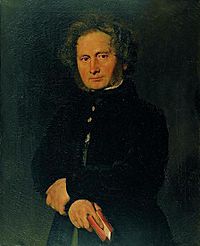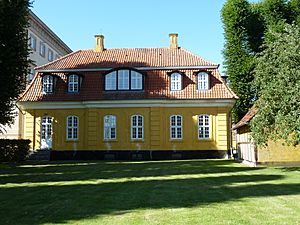Bernhard Severin Ingemann facts for kids
Quick facts for kids
Bernhard Severin Ingemann
|
|
|---|---|

Bernhard Severin Ingemann painted by Christian Albrecht Jensen in 1844
|
|
| Born | 28 May 1789 Falster, Denmark |
| Died | 24 February 1862 (aged 72) Sorø, Denmark |
| Occupation | Poet |
| Nationality | Danish |
| Literary movement | Romanticism |
| Spouse | Lucie Ingemann |
| Signature | |
 |
|
Bernhard Severin Ingemann (born May 28, 1789 – died February 24, 1862) was a famous Danish novelist and poet. He is known for his historical novels and beautiful hymns.
Contents
His Early Life and Works
Bernhard Severin Ingemann was born in Torkilstrup, a town on the island of Falster, Denmark. His father was a vicar, but he passed away when Bernhard was young.
Ingemann studied at the University of Copenhagen. While he was a student, he published his first collections of poems in 1811 and 1812. These early poems were influenced by the Romantic movement in Germany. He also wrote a long poem called De sorte Riddere (The Black Knights) in 1814.
After this, he wrote six plays. One of the best was Reinald Underbarnet (The Miraculous Child Reinald) in 1816. His play Blanca (1815) was also very popular. In 1817, he published his first prose story, De Underjordiske, et bornholmsk Eventyr (The Subterranean Ones, a Story of Bornholm). He followed this with Eventyr og Fortællinger (Narratives and Miraculous Tales) in 1820.
During 1818 and 1819, Ingemann traveled around Europe.
Becoming a Teacher and Novelist
In 1822, Ingemann became a teacher of Danish Language and Literature at the Academy of Sorø. This was an important time for him.
He was inspired by the historical novels of Walter Scott. Ingemann then began writing his own series of historical novels about Danish history. These books made him very popular, and some people even compare him to Hans Christian Andersen as a great Danish writer for young people.
His first historical novel, and perhaps his most famous, was Valdemar Sejr (Valdemar the Victorious) in 1826. This was followed by:
- Erik Menveds Barndom (Erik Menved's Childhood, 1828)
- Kong Erik og de Fredløse (King Erik and the Outlaws, 1833)
- Prins Otto af Danmark og Hans Samtid (Prince Otto of Denmark and his Time, 1835)
These novels helped introduce the idea of historical novels to Danish literature. They are filled with Danish history and culture.
Hymns and Friendships
Ingemann is also known as one of Denmark's greatest hymn writers. His hymns are simple and spiritual. His collection of religious poems, Morgen og Aftensange (Morning and Evening Songs), written between 1837 and 1839, became very popular. Many of these songs were set to music by the composer Christoph Ernst Friedrich Weyse.
Some of his hymns are still sung in Danish schools today, like I Østen stiger Solen op (In the East the Sun rises) and Fred hviler over Land og By (Peace is resting over Land and Town). His Christmas hymns are also very well-loved. He also wrote an epic poem about a legendary hero called Holger Danske (Ogier the Dane) in 1837.
Ingemann was good friends with N. F. S. Grundtvig, who was also a famous Danish writer and thinker. They shared a strong interest in Danish medieval history. He was also friends with other well-known writers like Steen Steensen Blicher and Hans Christian Andersen.
In his later years, Ingemann was highly respected. After the death of another famous poet, Adam Oehlenschläger, Ingemann was seen as the unofficial "poet-king" of Denmark. He was known for his graceful and delicate writing style. He passed away in Sorø in 1862.
Ingemann was married to Lucie Ingemann (1792–1868), who was a painter. Her artworks can still be seen in Danish churches today.
Written works
Songs
- I sne står urt og busk i skjul (1831)
- I alle de riger og lande (1837)
- I østen stiger solen op (1837)
- Lysets engel går med glans (1837)
- Nu titte til hinanden (1837)
- Dagen går med raske fjed (1838)
- Julen har bragt velsignet bud (1839)
- Den store mester kommer (1841)
- Stork! stork! Langeben! (1842)
- Dejlig er jorden (1850)
- Glade jul, dejlige jul (1850)
- Julen har englelyd (1569)
- Nu vågne alle Guds fugle små (1837)
Short stories
- Eventyr og Fortællinger (1820)
- Glasskabet (1847)
Epic poems
- Valdemar den Store og hans Mænd (1824)
- Dronning Margrete (1836)
- Holger Danske (1837)
Novels
- Valdemar Seier (1826)
- Erik Menveds Barndom (1828)
- Kong Erik og de Fredløse (1833)
- Prinds Otto af Danmark (1834)
See also
 In Spanish: Bernhard Severin Ingemann para niños
In Spanish: Bernhard Severin Ingemann para niños


